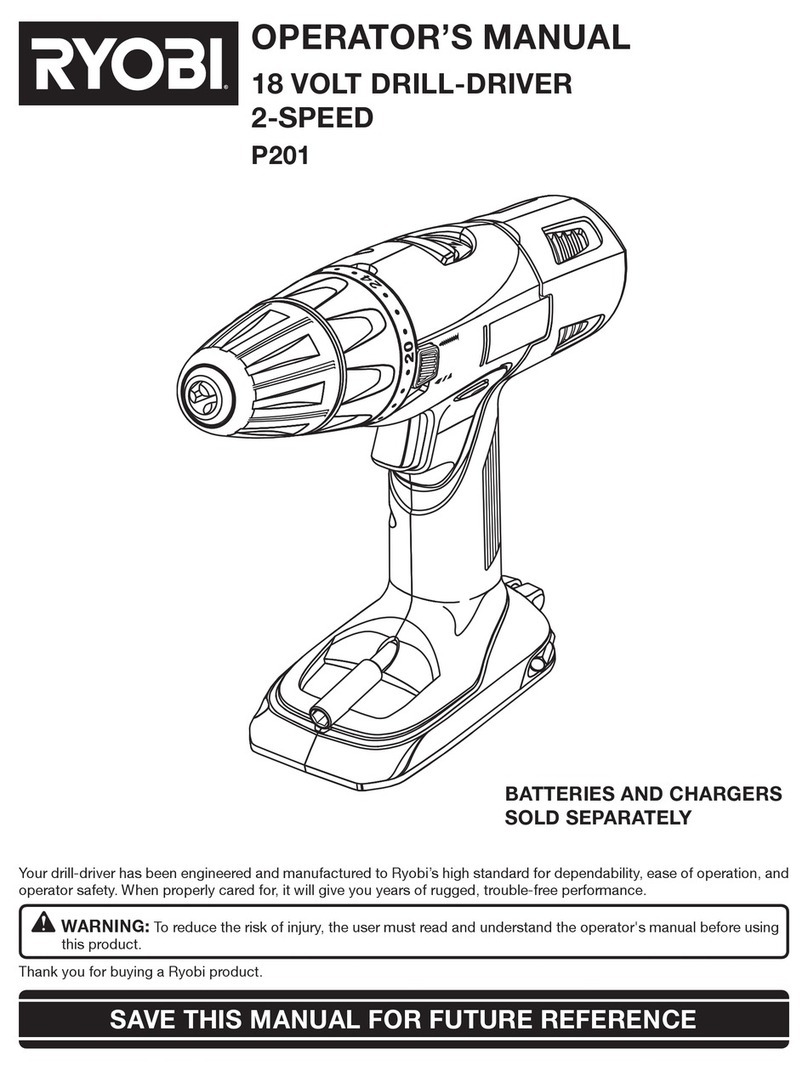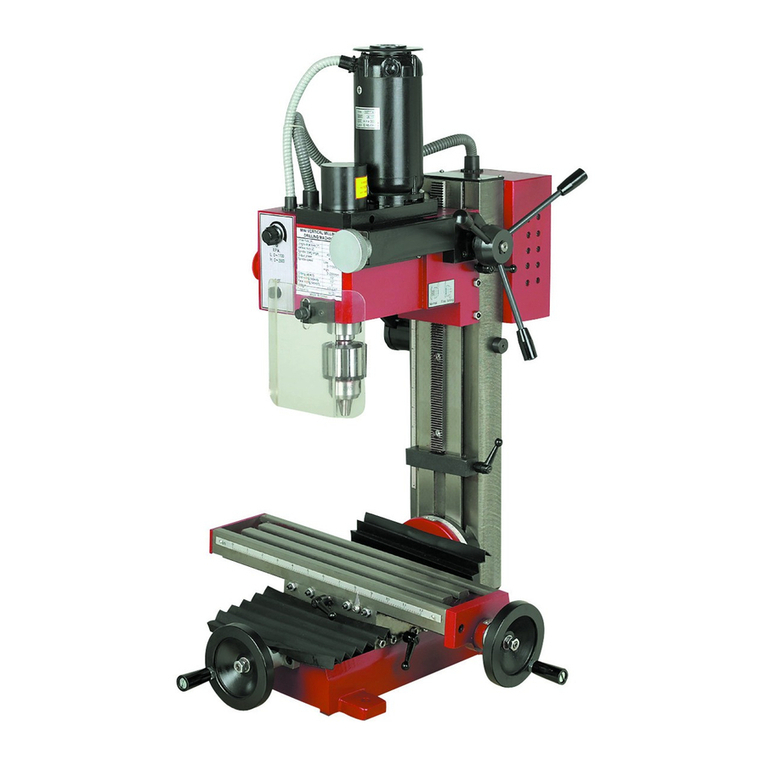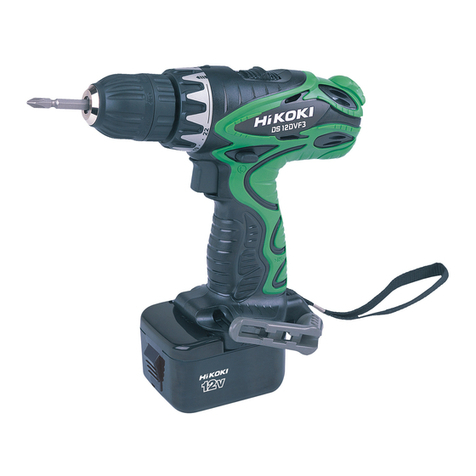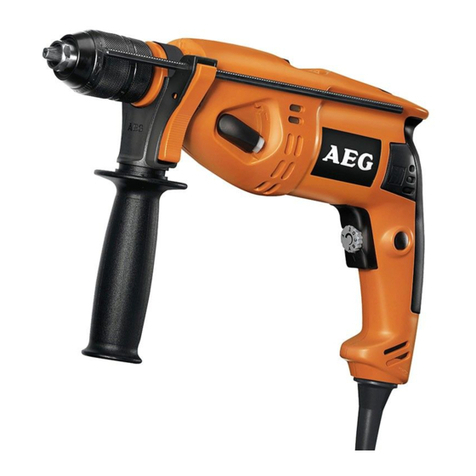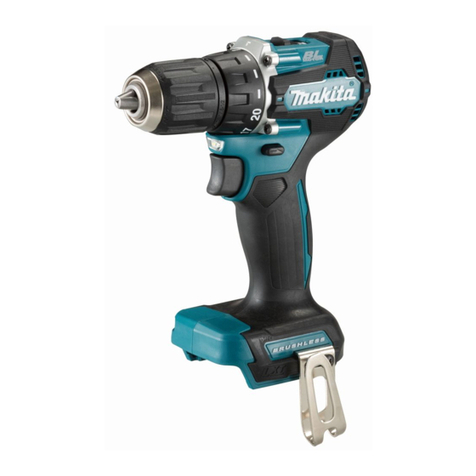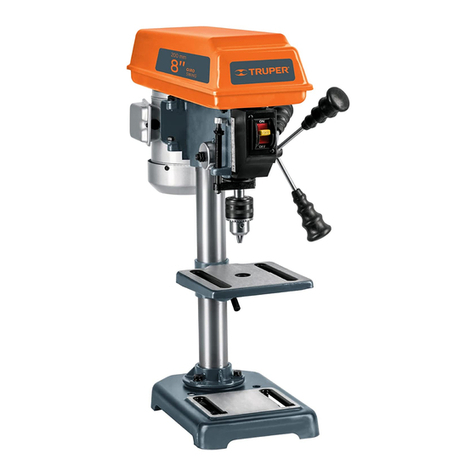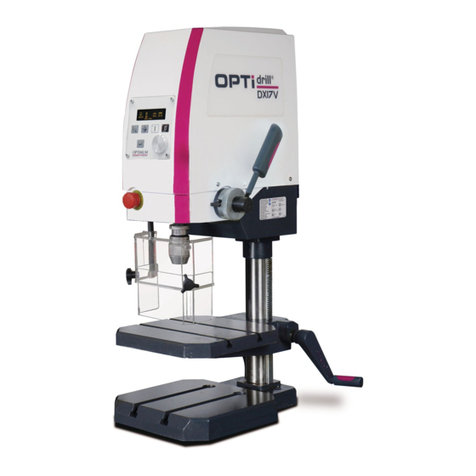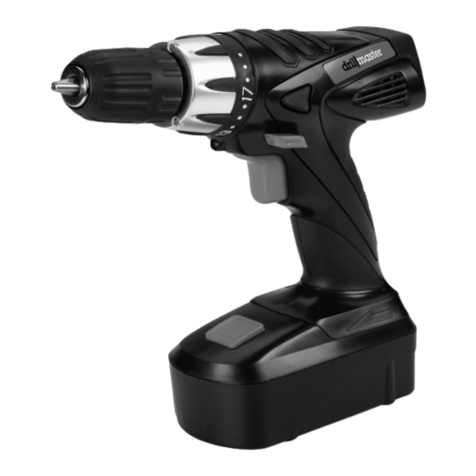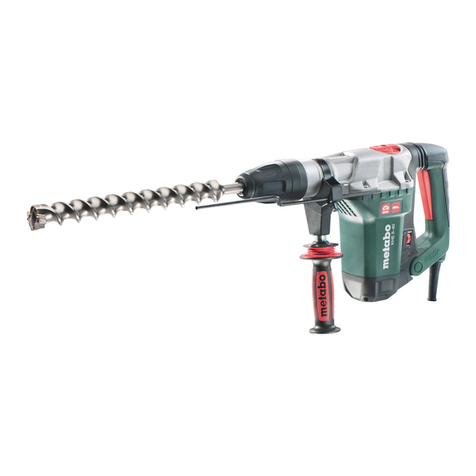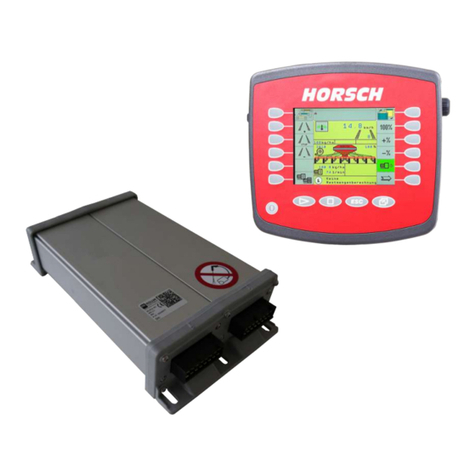TEI TE260 Installation and user guide

SERVICE AND
MAINTENANCE MANUAL
TE260
HYDRAULIC
DRIFTER
Blast hole and Foundation Drilling
January 2015

SERVICE AND MAINTENANCE MANUAL
FOR TE260 HYDRAULIC DRIFTER
This manual contains instructions for the maintenance, troubleshooting, and field repair of the TEI
ROCK DRILLS TE260. It is intended to help you maintain the drill and perform on-site repairs.
Read and understand this manual before operating or servicing this machine.
Keep this manual handy for future reference.
Both operator and service personnel must read this service
manual, particularly the warnings and cautions in Section
2, before operating this equipment. Your failure to do so
may result in dangerous practices which can cause serious
personal injury.

TEI ROCK DRILLS
The Hydraulic Drifter described in this literature is manufactured to TEI ROCK DRILLS exacting
standards.
For maximum utilization and efficiency in operating this equipment, we urge you to
thoroughly read the entire contents of this manual before you begin to drill.
ADDITIONAL MANUALS ARE AVAILABLE
Additional copies of this manual are available for purchase from TEI ROCK DRILLS. To order
please specify equipment model and serial number, quantity desired, type of manual, and remit $25
per manual with order. Make check payable to TEI ROCK DRILLS and mail to:
TEI ROCK DRILLS
P O Box 1309
Montrose, Colorado 81402
USA

TE260 SERVICE AND MAINTENANCE MANUAL
TABLE OF CONTENTS
INTRODUCTION SECTION 1
Specifications 1-1 thru 1-2
PRECAUTIONARY NOTICES SECTION 2
Operator Warnings 2-1
Equipment Cautions 2-2
MAINTENANCE SECTION 3
General Maintenance Tips 3-1
Maintenance Schedule 3-2 thru 3-5
Troubleshooting 3-6 thru 3-12
Nitrogen Charging Instructions 3-13
PARTS BOOK SECTION 4
TE260 Drill 4-1
TE260 Percussion Group 4-2
TE260 Parts Listing by Number 4-3 thru 4-4
TE260 Shank Listing by Number 4-5
TE2689X Mounting Slide 4-6
JB779X Nitrogen Charging Kit 4-7

INTRODUCTION
Section 1
Specifications 1-1 Thru 1-2
BEFORE ATTEMPTING MAINTENANCE OR REPAIR OF ANY COMPONENTS OF THIS MA-
CHINE, READ THE WARNINGS AND CAUTIONS LISTED IN SECTION 2

Section 1 Page 1-1

Section 1 Page 1-2
HYDRAULIC OIL SPECIFICATIONS
Mobile
DTE 24
Mobile
DTE 25
Mobile
DTE 26
Product Number 60262-3 60263-1 60264-9
Gravity, API 30.4 28.4 27.5
Specific Gravity 0.874 0.885 0.890
Pour point, ºC (ºF),
max
-23 (-10) -23 (-10) -23 (-10)
Flash point, ºC (ºF),
min
202 (395) 202 (395) 204 (400)
Viscosity,
cSt at 40º C
cST at 100º C
SUS at 100º F
SUS at 210º F
32
5.3
165
44
46
6.7
238
49
68
8.5
335
55
ISO Viscosity Grade 32 46 68
Viscosity index 95 95 95
Rust Protection,
ASTM D 665, A B
Pass Pass Pass
Color,
ASTM D 1500, max
3.5 4.0 4.0
Product: Primrose #327
NLGI Grade: 2SUS @ 100ºF: 2752
Non-Soap Base: Moly-Disulfide SUS @ 210ºF: 160
Penetration@
77º F, Worked:
280 cSt @ 40ºC: 512
Structure: Smooth/Tacky cSt @ 100ºC: 33
Drop Pt. ºF, min: None (non-melt) Color Visual Dark Green
GREASE SPECIFICATIONS

PRECAUTIONARY NOTICES
Section 2
Operator Warnings 2-1
Equipment Cautions 2-2
BEFORE ATTEMPTING MAINTENANCE OR REPAIR OF ANY COMPONENTS OF THIS MA-
CHINE, READ THE WARNINGS AND CAUTIONS LISTED IN SECTION 2

OPERATOR WARNINGS
Your first consideration, when servicing your TE260,
must be your personal protection and that of others.
Correct servicing is a matter of being completely
familiar with your machine and the job it is intended to
do. Carefully read and understand the warnings listed
below, and most of all remember to apply good common
sense at all times.
1. DO NOT OPERATE DRILLING CONTROLS
UNLESS YOU ARE THOROUGHLY FAMILIAR
WITH FUNCTIONS.
2. DO NOT OPERATE THE TE260 HYDRAULIC
DRILL UNLESS ACCUMULATORS HAVE BEEN
CHARGED.
3. WEAR A PROTECTIVE HELMET AND EYE
PROTECTION WHEN OPERATING OR NEAR THE
DRILL CARRIER.
4. WEAR NOISE-REDUCING EAR PROTECTION
WHEN NEAR THE MACHINE FOR EXTENDED
PERIODS WHILE THE MACHINE IS RUNNING.
5. DO NOT ATTEMPT LUBRICATION OR
SERVICE WHILE MACHINE IS RUNNING.
6. BE SURE THE HYDRAULIC AND PNEUMATIC
SYSTEMS ARE NOT PRESSURIZED BEFORE
LOOSENING ANY CONNECTIONS OR PARTS.
7. REMOVE DRILLSTEEL AND LOWER THE
DRILL TO CENTRALIZE BEFORE TRAMMING.
8. BEFORE STARTING THE ENGINE, BE SURE
ALL HYDRAULIC CONTROLS ON THE DRILL
AND CARRIER ARE IN THE OFF OR NEUTRAL
POSITION.
9. BE SURE ALL HYDRAULIC HOSE
CONNECTIONS ARE TIGHT, AND HOSE
RETAINERS IN PLACE.
10. KEEP ALL PERSONNEL AWAY FROM THE
HOLE WHILE DRILLING IS IN PROGRESS.
11. DO NOT REDRILL ANY BLAST HOLE.
12. DO NOT STRIKE THE DRILL STEEL TO
DISLODGE IT WHILE THE DRILL IS OPERATING.
FRAGMENTATION OF THE DRILL STEEL MAY
RESULT.
13. BE SURE THE DRILL STEEL COUPLING DOES
NOT UNTHREAD TOTALLY FROM BOTH DRILL
STEEL AND SHANK.
14. IF BIT BECOMES PLUGGED, DETATCH BIT FROM
STEEL TO REMOVE OBSTRUCTION. NEVER
HAMMER ON BIT OR STEEL. FRAGMENTATION CAN
PRODUCE SERIOUS INJURY.
15. BEFORE ATTEMPTING TO REMOVE DRILL FROM
FEED, RELIEVE STANDING PRESSURE.
16. USE CAUTION WHEN CHECKING FOR LEAKS.
FLUID UNDER PRESSURE MAY PENETRATE THE
SKIN.
17. DRILL AND FEED MUST BE IN THE HORIZONTAL
POSITION FOR DISASSEMBLY.
18. IF RIG IS TO BE OPERATED WITH DRILL
DISMOUNTED, SECURE AND CAP ALL LOOSE
FITTINGS AND CONNECTIONS.
19. DO NOT REMOVE THE ACCUMULATOR COVERS
BEFORE COMPLETELY BLEEDING OFF THE GAS
CHARGE IN THE ACCUMULATOR.
20. THOROUGHLY TEST ALL REPAIRS BEFORE
PUTTING EQUIPMENT INTO SERVICE.
Section 2 Page 2-1

EQUIPMENT CAUTIONS
The following are good practices to observe
for protecting the equipment and drills from
damage, and to provide maximum life for the
machine:
1. MAINTENANCE OF TE260 HAMMER,
BEARINGS, ACCUMULATORS, VALVE
ASSEMBLY OR STROKE CONTROL MUST BE
PERFORMED IN A CLEAN SHELTERED AREA.
THE ONE OVERRIDING RULE IN MAINTAINING
HYDRAULIC EQUIPMENT IS CLEANLINESS.
PREVENTION OF CONTAMINATION IN
HYDRAULIC FLUIDS IS THE MOST IMPORTANT
FACTOR IN MAINTAINING HIGH PERFORMANCE
IN TODAYS HYDRAULIC EQUIPMENT. AT ONE
TIME WHEN MACHINES OPERATED AT LOW
SPEEDS AND LOW TEMPERATURES
CLEANLINESS WAS A VIRTUE, TODAY IT IS A
NECESSITY.
2. KEEP THE DRILL LUBRICATED. APPLY
GREASE DAILY, OR WHEN INDICATED (MORE
OFTEN IN HOT CLIMATES) TO THE GREASE
FITTINGS AT THE CHUCK END OF THE DRILL.
3. PERIODICALLY INSPECT HOSE RETAINERS
AND HOSES FOR INDICATION OF WEAR,
LOOSENESS, CRACKING, OR FRAYING.
4. FREQUENTLY CHECK ALL NUTS, BOLTS,
AND ADJUSTMENTS FOR PROPER TENSION.
5. BE SURE THE HYDRAULIC RESERVOIR IS
ALWAYS FILLED TO THE RECOMMENDED
LEVEL WITH THE PROPER TYPE HYDRAULIC
FLUID. DO NOT MIX TYPES OF FLUID.
6. KEEP ALL BITS SHARP AND PERIODICALLY
CHECK FOR BROKEN OR LOOSE CARBIDES.
7. EXCESSIVELY WORN THREADS ON THE
DRILL STRING CAN CAUSE PREMATURE WEAR
AND BREAKAGE OF NEW PARTS MATED WITH
THE STRING.
8. DO NOT OPERATE THE DRILL ROTATION AND
FEED AT FULL THROTTLE UNTIL SURE OF ROCK
CONDITIONS. OVER FEEDING AND OVER ROTATION
CAN CAUSE BREAKAGE OF DRILL ROTATION
PARTS AND THE DRILL STRING
9. FREE OSCILLATION (DRY FIRING) OF DRILL
WILL RESULT IN PREMATURE WEAR OR FAILURE
OF CYLINDER AND HAMMER SEALS.
10. BEFORE REMOVING ANY LINES OR HOSES, TAG
EACH TO FACILITATE REASSEMBLY.
11. CAP OR PLUG ALL HYDRAULIC AND
PNEUMATIC CONNECTIONS AFTER DISASSEMBLY
TO PREVENT CONTAMINATION OF THE SYSTEM.
12. CLEAN THE EXTERIOR OF ALL PARTS AND
HOSE CONNECTIONS BEFORE REMOVING.
13. DO NOT OPPERATE THE TE260 HYDRAULIC
DRILL UNTIL ACCUMULATORS HAVE BEEN
CHARGED.
14. BEFORE REASSEMBLING HYDRAULIC
COMPONENTS, CLEAN ALL METAL PARTS IN A
NON-FLAMMABLE CLEANING FLUID.
15. THOROUGH CHECKS MUST BE MADE OF ALL
REASSEMBLIES TO BE SURE THEY ARE
ASSEMBLED PROPERLY ACCORDING TO
INSTRUCTIONS. DO NOT DRILL UNTIL ALL CHECKS
HAVE BEEN MADE.
Section 2 Page 2-2

MAINTENANCE
Section 3
General Maintenance 3-1
Tips
Maintenance Schedule 3-2 thru 3-5
Troubleshooting 3-6 thru 3-12
Parts Wear Tolerances 3-13
Nitrogen Charging 3-14
Instructions
BEFORE ATTEMPTING MAINTENANCE OR REPAIR OF ANY COMPONENTS OF THIS
MACHINE, READ THE WARNINGS AND CAUTIONS LISTED IN SECTION 2

GENERAL TIPS ON DRILL
MAINTENANCE
These general instructions will be helpful when
using the maintenance and adjustment
procedures outlined on the following pages.
1. Cover all hydraulic or air openings with an
appropriate dust cover when any hydraulic
or air openings are exposed. A clean part in
a dirty opening does little good.
2. Carefully examine all filters for evidence
of metal or rubber particles. Replace the
filters as necessary.
3. Before servicing the drill or any part of the
hydraulic system, neutralize the pressure in
the complete hydraulic system.
4. Before reassembling hydraulic
components, clean all metal parts in a non-
flammable cleaning fluid. Carefully
lubricate all components to aid in
reassembly.
5. Thorough checks must be made of all
reassemblies to be sure they are assembled
properly according to the instructions. Do
not drill until all checks have been made.
6. Frequent inspection of the TE260 is very
good practice. A minor adjustment can
many times prevent costly repairs later on.
7. Maintenance of hammer, bearings,
accumulators, valve assembly or stroke
control must be performed in a clean
sheltered area.
8. Maintenance of chuck end or rotation
assemblies may be performed on a
mounted drill.
9. It is not necessary to bleed off nitrogen
charge in accumulators unless maintenance
is performed on accumulator assemblies.
IMPORTANT
All TEI ROCK DRILL parts are
manufactured with care and precision.
Each part is carefully inspected before and
after assembly. Every step has been taken
to provide you with the quality product you
expect. Eventually some parts of your drill
will become worn. The description of
damaged parts in this section is general,
and is intended to help the servicemen in
the field to service and repair the TE260. It
is not meant to imply that all such parts
will fail in the described manner, or that
damage is due to faulty manufacture.
Section 3 Page 3-1

Before performing any maintenance make certain of the following:
1. Only qualified personnel should perform service on the TE260 Drifter.
2. Use only original TEI factory parts
3. Make certain maintenance is performed in a clean/sheltered area.
4. Only qualified personnel should perform cleaning, lubricating, service and repair of the drill.
5. Make certain all bolts and screws are properly torqued according to manufacturers
recommendations.
6. Ensure that all waste is disposed of according to environmental regulations.
DAILY MAINTENANCE
Normal operation of the TE260 requires daily greasing of the front rotation housing every 2
percussion hours using a moly disulfide high temperature type grease. This is most important to
prevent galling and failure of the rotation gears and bearings. During the first week of operation or
after replacement of the accumulator diaphragm, the charge pressure must be checked daily. In
addition all hydraulic hoses must be inspected for chafing and pinched or damaged sections. The
hydraulic oil must be checked for proper level and color. A white or milky appearance or foaming
of hydraulic oil indicates water contamination. Continued operation with contaminated oil will
damage both the drill and pump. Hydraulic oil must be equivalent to mobile DTE-24 through DTE-
26 depending on ambient operating temperature.
WEEKLY MAINTENANCE
During the weekly check, the front end cap (TE26234G) and grout/water swivel (TE26823G40)
must be removed to check the chuck. Pull the shank from the housing. Remove the thrust washer
(TE30835SK), chuck (TE357) and thrust block (TE35161). Check for burning of the splines
indicating lack of lubrication. The thrust blocks (TE35161) must be checked for cracks and
deformation at the shank spline contact surface. Replace if worn more than 1/16”(2mm) into face.
Charge pressure of the accumulator must also be checked weekly. Excessive cab vibration and/or
hose jumping and overheating of the hydraulic oil indicates a blown or uncharged accumulator. The
high pressure accumulator should be charged between 800 to 950 psi using nitrogen gas. The low
pressure accumulator requires 95 to 125 psi charge pressure depending on the system back
pressure.
Caution: Remember that disassembly beyond the removal of the chuck end cap or removal of
the rotation motor should be done in a clean, dust free area. It is essential that no dirt
particles enter the internal part of the drill and especially in the hydraulic fluid.
MONTHLY MAINTENANCE
With the shank removed as above, remove the 4 bolts retaining the front retaining plates (TE25557)
to the rotation housing. The front plate (RD25281) is then removed. Check the pinion thrust bearing
(RB24338) for wear and breakage. Replace if necessary.
Section 3 Page 3-2

MONTHLY MAINTENANCE cont’d
Push the chuck driver and pinion gear sideways to check bearing wear, if motion is greater than
1/32”(1mm) it requires replacement of the chuck driver and pinion bearings. Check the inner
bearings as above.
Every six months or 1,000 percussion hours, the drill must be inspected for hammer and bearing
seal wear. Maintenance of hammer, bearings, accumulators, valve assembly or stroke control
must be performed in a clean sheltered area.
YEARLY INSPECTION AND OR COMPLETE REBUILD
Send to TEI Factory or Authorized TEI Distributor
Section 3 Page 3-3

Section 3 Page 3-4
PART NUMBER DESCRIPTION QTY
TE26778 COMPLETE SEAL KIT 1
TE30706SK GROUT/WATER SEAL 8
TE30350 DIAPHRAGM 2
1050094 VALVE 1
TE55183SX BOLT, GROUT SWIVEL 2
TE35161 THRUST BLOCK 1
TE357 CHUCK 1
TE30835SK THRUST WASHER 1
TE3549---- SHANK, SPECIFY THREAD 1
ST16204 BUSHING, STEEL 2
SB48528 BEARING, BRONZE 1
RB24338 BEARING, ROLLER 2
TE260 Recommended Spare Parts

HYDRAULIC OIL SPECIFICATIONS
Mobile
DTE 24
Mobile
DTE 25
Mobile
DTE 26
Product Number 60262-3 60263-1 60264-9
Gravity, API 30.4 28.4 27.5
Specific Gravity 0.874 0.885 0.890
Pour point, ºC (ºF),
max
-23 (-10) -23 (-10) -23 (-10)
Flash point, ºC (ºF),
min
202 (395) 202 (395) 204 (400)
Viscosity,
cSt at 40º C
cST at 100º C
SUS at 100º F
SUS at 210º F
32
5.3
165
44
46
6.7
238
49
68
8.5
335
55
ISO Viscosity Grade 32 46 68
Viscosity index 95 95 95
Rust Protection,
ASTM D 665, A B
Pass Pass Pass
Color,
ASTM D 1500, max
3.5 4.0 4.0
GREASE SPECIFICATIONS
Product: Primrose #327
NLGI Grade: 2SUS @ 100ºF: 2752
Non-Soap Base: Moly-Disulfide SUS @ 210ºF: 160
Penetration@
77º F, Worked:
280 cSt @ 40ºC: 512
Structure: Smooth/Tacky cSt @ 100ºC: 33
Drop Pt. ºF, min: None (non-melt) Color Visual Dark Green
Section 3 Page 3-5

TE260 TROUBLESHOOTING
PROBLEM
A. Drilling rate falls off quickly,
supply hoses pulsate
excessively, hoses heat up,
drill vibrates excessively
B. Drill bounces and vibrates
excessively
C. Rotation speed rapidly drops
or rotation fails to work
D. Loss of blowing air
E. Drilling rate decreases slowly
but steadily
PROBABLE CAUSES
High pressure accumulator has lost
pressure
Too little feed pressure
High pressure accumulator has lost
pressure
Hydraulic lines blocked
Failure of rotation motor or drill
rotation assembly
Broken shank
Lose of pressure due to leakage
Plugged drill bit
Air line to drill has been
interrupted
Dull or broken drill bits
Accumulators not charged to
correct pressures
Oil temperature to high
Hydraulic pump not maintaining
pressure
REMEDY
Recharge or replace high pressure
accumulator diaphragm or fill
valve
Adjust feed compensator relief
valve
Recharge or replace high pressure
accumulator diaphragm or fill
valve
Check hoses and fittings for leaks,
replace
Check rotation motor and rotation
assembly; replace worn parts
Replace shank; check related parts
for damage
Check hoses and fittings for leaks;
replace
Detach bit from steel and remove
obstruction;
WARNING: Do not
Hammer on Bit or Steel
Check blowing system
Sharpen bits; periodically check
for broken or loose carbides
Check charging pressures; charge
if necessary
Check hydraulic system
Check pump; replace if necessary
Section 3 Page 3-6

TE260 TROUBLESHOOTING
PROBLEM
F. Drilling rate falls off quickly
G. Hammer oscillation stops
immediately or won’t start
H. Drill will hammer but won’t
rotate
PROBABLES CAUSES
Hydraulic lines have been torn or
crushed
Severe hydraulic leakage
Shank failure
Hammer inside cylinder is
damaged
Stuck or broken shuttle valve
Stuck or broken hammer (oil will
leak from rotation housing and
backhead if hammer is broken)
Supply or return hose damaged or
clogged
Hose to rotation collapsed or
kinked
Coupling failure
Rotation motor fouled with
foreign material
Broken shank
Worn chuck (splines completely
gone)
Hydraulic control valve failure
Rotation gear failure
REMEDY
Check hydraulic system
Check and replace faulty part
Replace shank and check related parts
for damage
Inspect cylinder, backhead, and
hammer for galling and/or scoring;
replace assembly if necessary
Remove tie rod and inspect shuttle
valve and valve body
Inspect cylinder, backhead, and
hammer for galling and/or scoring;
replace assembly if necessary
Check for drill supply pressure at
console
Replace
Replace
Clean and inspect; replace worn parts
Replace
Replace
Repair or replace valve
Replace worn parts
Section 3 Page 3-7

TE260 TROUBLESHOOTING
PROBLEM
I. Drill rotates but won’t hammer
J. Drill operates inefficiently
PROBABLE CAUSE
Leaky oil hose
Broken hammer
Lines are backwards
Hose to drill collapsed or kinked
Improper feed adjustment
Leaking oil hose
Worn bit
Hydraulic system out of adjust-
ment
Poor hole cleaning
Hole misalignment (bent drill rod)
Low drill pressure
Low feed pressure
Broken shank or drill rod
Thrust collar broken
Accumulator not charged correctly
REMEDY
Replace
Replace complete cylinder and
hammer assembly
Check supply and return lines
Check and replace hose
Adjust
Replace
Sharpen bit; check for loose or
broken carbides
Check pump pressure and flow
Check bit and steel for plugged air
passage
WARNING: DO NOT
HAMMER ON BIT OR
STEEL
Align feed properly
Set high pressure compensator to
2500 psi
Adjust pressure
Replace broken parts
Replace thrust collar. [check for
1/2”-1” (13-25mm) exposure of
shank guiding diameter beyond
front seal with shank pushed into
drill against the stop.]
Charge accumulator
Section 3 Page 3-8

TE260 TROUBLESHOOTING
PROBLEM
K. Rapid chuck driver bushing
wear
L. Rapid failure of rotation
bearings
M. Oil leak around shank
N. Oil leak around backhead
O. Oil leaking from accumulator
charge valve
P. Hydraulic oil in blowing air
PROBABLE CAUSE
Worn and scored shank
Improper feed pressure
Insufficient lubrication
Contamination in chuck end of
drill
Bearings dirty
Dull bit
Misapplication
Shank seals in chuck end worn or
ruptured
Hammer seal failure
O ring on hammer bearing leaking
Hammer seal failure
Accumulator diaphragm ruptured
Valve worn
Check hydraulic and air system of
rig for leaks
REMEDY
Replace
Adjust
Grease chuck end more frequently
Clean parts; check front seal and
grout swivel seals, replace
Clean parts; blow all hoses before
assembly
Sharpen bit
Attempting too large a hole for
ground conditions and equipment
Remove chuck end cap and chuck
end; replace shank seals, ruptured
and worn parts
Replace
Replace
Replace
Replace diaphragm and recharge
accumulator
Replace
Repair or replace as necessary
Section 3 Page 3-9
Table of contents

